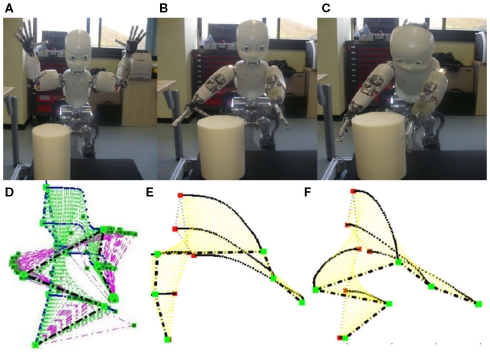Figure 4.
Effects of modulating the admittance in the intrinsic space on the final posture achieved through PMP relaxation. (A) Shows the initial condition with the goal being issued to reach the large cylinder (placed far away and asymmetrically with respect to the robot’s body) using both arms. (B) Shows the final solution when the admittance of the three DoF of the waist is reduced 10 times as compared to the two arms. Without the contributions of the additional DoF of the torso, it is not possible to bimanually reach the target. An alternative way to interpret this behavior is that the force field induced by the goal did not propagate through the waist network because of its lower admittance (in comparison with the arm networks). In other words, the propagation of goal induced force field across different intrinsic elements of the body can be modified by altering their “local” admittance. (C) Shows the solution when the waist admittance is made equal to the arms. In this case, note the contributions from all three degrees of freedom of the torso (B), hence enabling iCub to bimanually reach the cylinder successfully in this case. (D–F) Show a simple scenario where the goal is to reach a target using the whole body but also attain a specific posture as demonstrated by the teacher [(D): Nearby target, (E,F) far way target]. If the admittance of the hip was reduced from 2.5 to 0.1 (rad/s/Nm) in (F) (keeping admittance of other joints constant), and we see two different postures: one that uses the hip more (E) and the other in which the knees compensate for the low admittance of the hip (F). This local and modular nature of motion generation is also evident during injury, when other degrees of freedom compensate for the temporarily “inactive” element, in reaction to the pull of a goal. This is a natural property of the PMP mechanism.

